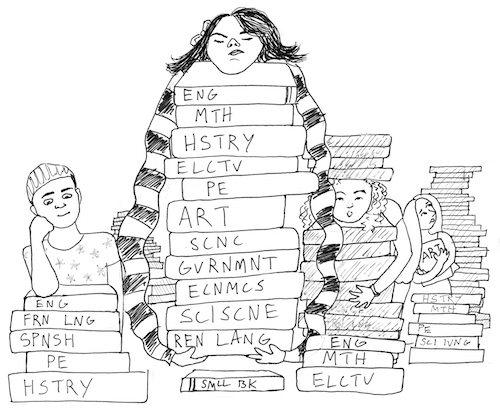Illustration by Siena Laws
Through what are commonly known as the A-G requirements, high school students are forced to take certain required classes if they plan to graduate and be admitted to a University of California (UC) or a California State University (CSU). These requirements make students take an array of specific courses for specified years. Although these requirements intend to help prepare students for college, they also extinguish their curiosity, and can instead make students feel like they’re just checking off boxes. To solve the problem, certain courses along with a certain number of years, should still be required, but students should be given more academic freedom with which courses they use to fulfill the requirements.
A-G requirements are designed to ensure that students are prepared to attend a UC or CSU for four years, and so the added difficulty of college courses won’t prove too much for them. The fact is that in this sense, these courses serve their purpose. They give students a well rounded education while also teaching them essential skills such as critical thinking or the ability to write long essays. They also force students to challenge themselves, when they might otherwise choose to take an easier class.
That being said, the pile of courses these requirements drop onto students can sometimes work against them. They leave little room for electives, and force many students to continue studying fields they have no interest in pursuing. While this is not entirely a bad thing, the student should still have a right to draw the line somewhere. If they would rather take ceramics than Advanced Placement Biology, then let them. Jack Egawa, a junior in Academic Choice, said, “I should be able to take classes that I feel are better suited to a future I want to pursue rather than being forced to take classes that are irrelevant to my life after high school.”
Another fault in A-G requirements is the amount of classes that have a “recommended” additional year. This is unclear to students, because with the ever increasing competition for college admissions, they feel that they have to take these.
When you compare the A-G requirements with those of Berkeley High School (BHS), the result is a full schedule without much space to take electives. This creates a bad classroom culture, one where students are there to check off a requirement rather than to gain knowledge. Just one look into a Law and Social Justice class, a popular BHS elective, reveals a more engaged classroom environment.
The solution is simple. Keep A-G requirements, stop recommending extra years, and give students more freedom in which classes they can use to fulfill the requirements.
Part of the problem at BHS is that small schools often force students to take certain classes too. If small schools allowed more exceptions, and the UC’s and CSU’s gave more freedom to students as they attempt to meet the A-G requirements, then students would be free to explore their academic interests. This way students would gain essential skills for college while learning about their passions, and colleges would get students who are prepared and eager.


